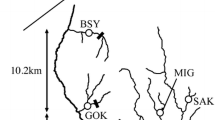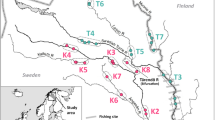Abstract
Delineating population genetic structure and gene flow is a critical for identifying evolutionary processes and effective conservation. In this study, we examined the genetic structure of masu salmon (Oncorhynchus masou) populations within the Atsuta River, Hokkaido, Japan. In addition, to infer whether dispersers contribute to next generation’s gene pool, a comparison between the genetic structure of juvenile and adult masu salmon was conducted. Significant genetic differentiation and isolation by distance were observed among populations of both juveniles and adults. The degree of genetic differentiation was larger among the juvenile samples, especially among geographically distant samples, than among the adults. These results suggest that a number of relatively stable discrete populations are maintained in the river and that the reproductive success of dispersers to distant tributaries was relatively low among distant tributaries.


Similar content being viewed by others
References
Benjamini Y, Yekutieli D (2001) The control of the false discovery rate in multiple testing under dependency. Ann Stat 29:1165–1188
Bohonak AJ (1999) Dispersal, gene flow, and population structure. Quarterly Rev Biol 74:21–45
Castric V, Bernatchez L (2004) Individual assignment test reveals differential restriction to dispersal between two salmonids despite no increase of genetic differences with distance. Mol Ecol 13:1299–1312
Castric V, Bernatchez L, Belkhir K, Bonhomme F (2002) Heterozygote dificiencies in small lacustrine populations of brook charr Salvelinus fontinalis Mitchill (Pisces, Salmonidae): a test of alternative hypotheses. Heredity 69:27–35
Clobert J, Danchin E, Dhondt AA, Nichols JD (2001) Dispersal. OxfordUniversity Press, Oxford
De Meester L, Gómez A, Okamura B, Schwenk K (2002) The monopolization hypothesis and the dispersal-gene flow paradox in aquatic organisms. Acta Oecol 23:121–135
Frankham R, Ballow JD, Briscoe DA (2004) A primer of conservation geneticsl. Cambridge University Press, Cambridge
Garant D, Dodson JJ, Bernatchez L (2000) Ecological determinants and temporal stability of the within-river population structure in Atlantic salmon (Salmo salar L.). Mol Ecol 9:615–628
Gomez-Uchida D, Knight TW, Ruzzante DE (2009) Interaction of landscape and life history attributes on genetic diversity, neutral divergence and gene flow in a pristine community of salmonids. Mol Ecol 18:4854–4869
Goudet J (2001) FSTAT, a program to estimate and test gene diversities and fixation indices (version 2.9.3). Lausanne, Switzerland: Population Genetics Laboratory, University of Lausanne
Hansen MM, Nielsen EE, Mensberg KLD (1997) The problem of sampling families rather than populations: relatedness among individuals in samples of juvenile brown trout Salmo trutta I. Mol Ecol 6:469–474
Hasegawa K, Yamamoto T, Kitanishi S (2010) Habitat niche separation of the nonnative rainbow trout and native masu salmon in the Atsuta River, Hokkaido Japan. Fish Sci 76:251–256
Heggenes J, Røed KH, Jorde PE, Brabrand Å (2009) Dynamic micro-geographic and temporal genetic diversity in vertebrates: the case of lake-spawning populations of brown trout (Salmo trutta). Mol Ecol 18:1100–1111
Hendry AP (2004) Selection against migrants contributes to the rapid evolution of ecologically depencent reproductive isolation. Evol Ecol Res 6:1219–1236
Hendry AP, Castric V, Kinnison MT, Quinn TP (2004) The evolution of philopatry and dispersal. In: Hendry AP, Stearns SC (eds) Evolution Illuminated. Oxford University Press, Ney York, pp 52–91
Jensen JL, Bohonak AJ, Kelley ST (2005) Isolation by distance, web service. BMC Genet 6:13
Kasugai K, Takami T, Aoyama T, Takeuchi K, Miyakoshi Y, Nagata M (2008) Relationship between physical environment and distribution of juvenile masu salmon in early summer in the Atsuta River, Hokkaido. Sci Rep Hokkaido Fish Hatchery 62:27–38
Kato F (1991) Life histories of masu and amago salmon (Oncorhynchus masou and O. rhodurus). In: Groot C, Margolis L (eds) Pacific Salmon Life Histories. University of British Columbia Press, Vancouver, pp 447–520
Kitanishi S, Yamamoto T, Higashi S (2009) Microsatellite DNA reveals fine-scale genetic structure of masu salmon, Oncorhynchus masou, populations within the Atsuta River. Ecol Freshw Fish 18:65–71
Kitanishi S, Yamamoto T, Koizumi I, Dunham JB, Higashi S (2012) Fine scale relationships between sex, life history, and dispersal of masu salmon. Ecol Evol 2:920–929
Meirmans PG, Hedrick PW (2011) Assessing population structure: FST and related measures. Mol Ecol Resour 11:5–18
Neville HM, Isaak DJ, Dunham JB, Thurow RF, Rieman BE (2006) Fine-scale natal homing and localized movement as shaped by sex ands spawning habitat in Chinook salmon: insights from spatial autocorrelation analysis of individual genotypes. Mol Ecol 15:4589–4602
Olsen JB, Wilson SL, Kretschmer EJ, Jones KC, Seeb JE (2000) Characterization of 14 tetranucleotide microsatellite loci derived from sockeye salmon. Mol Ecol 9:2185–2187
Palti Y, Fincham MR, Rexroad CE III (2002) Characterization of 38 polymorphic microsatellite markers for rainbow trout (Oncorhynchus mykiss). Mol Ecol Notes 2:449–452
Peakall R, Smouse PE (2012) GenAlEx 6.5: genetic analysis in Excel. Population genetic software for teaching and research-an update. Bioinformatics 28:2537–2539
Primmer CR, Veselov AJ, Zubehenko A, Poututkin A, Bakhmet I, Koskinen MT (2006) Isolation by distance within a river system: genetic population structuring of Atlantic salmon, Salmo salar, in tributaries of the Varzuga River in northwest Russia. Mol Ecol 15:653–666
Quinn TP, Dittman AH (1990) Pacific salmon migrations and homing: mechanisms and adaptive significance. Trends Ecol Evol 5:174–177
Raymond M, Rousset F (1995) GENEPOP (version 1.2): Population genetics software for exact tests and ecumenicism. J Heredity 86:248–249
Rexroad CE III, Coleman RL, Hershberger WK, Killefer J (2002) Eighteen polymorphic microsatellite markers for rainbow trout (Oncorhynchus mykiss). Anim Genet 33:76–78
Rodriguez F, Rexroad CE III, Palti Y (2003) Characterization of twenty-four microsatellite markers for rainbow trout (Oncorhynchus mykiss). Mol Ecol Notes 3:619–622
Rousset F (1997) Genetic differentiation and estimation of gene flow from F-statistics under isolation by distance. Genetics 145:1219–1228
Slatkin M (1987) Gene flow and the geographic structure of natural populations. Science 236:787–792
Sugiwaka K-I, Kojima H (1984) Influence of individual density on smoltification in wild juvenile masu salmon (Oncorhynchus masou) in the Atsuta River. Sci Rep Hokkaido Fish Hatch 39:19–37 [in Japanese with English abstract]
Sugiwaka K-I, Takeuchi K, Suzuki KT, Nagata M, Miyamoto M, Kawamula H (1999) Distribution and structure of spawning redds of masu salmon in the Atsuta River. Sci Rep Hokkaido Fish Hatch 53:11–28 [in Japanese with English abstract]
Vähä J-P, Erkinaro J, Niemelä E, Primmer CR (2007) Life-history and habitat features influence the within-river genetic structure of Atlantic salmon. Mol Ecol 16:2638–2654
Yamamoto T, Edo K (2002) Reproductive behaviors related to life history forms in male masu salmon, Oncorhynchus masou Breboort, in Lake Toya, Japan. J Fresh Ecol 17:275–281
Acknowledgments
We are grateful to H. Omiya, T. Endo, C. Uehara, and T. Kobayashi for their assistance in collecting samples. David L. G. Noakes and two anonymous reviewers provided comments that helped to improve the manuscript. This research was supported in part by the River Fund in charge of the Foundation of River and Watershed Environment Management (FOREM), Japan, and JSPS KAKENHI Grant Number 24710278. This study was conducted with the permission of the Hokkaido Government.
Author information
Authors and Affiliations
Corresponding author
Rights and permissions
About this article
Cite this article
Kitanishi, S., Yamamoto, T. Comparison of genetic structure between juvenile and adult masu salmon indicates relatively low reproductive success of dispersers. Environ Biol Fish 98, 405–411 (2015). https://doi.org/10.1007/s10641-014-0271-6
Received:
Accepted:
Published:
Issue Date:
DOI: https://doi.org/10.1007/s10641-014-0271-6




